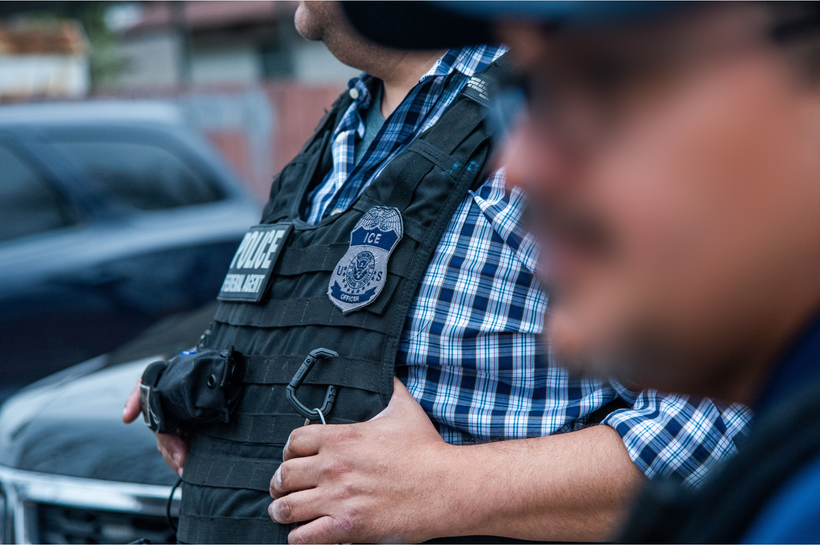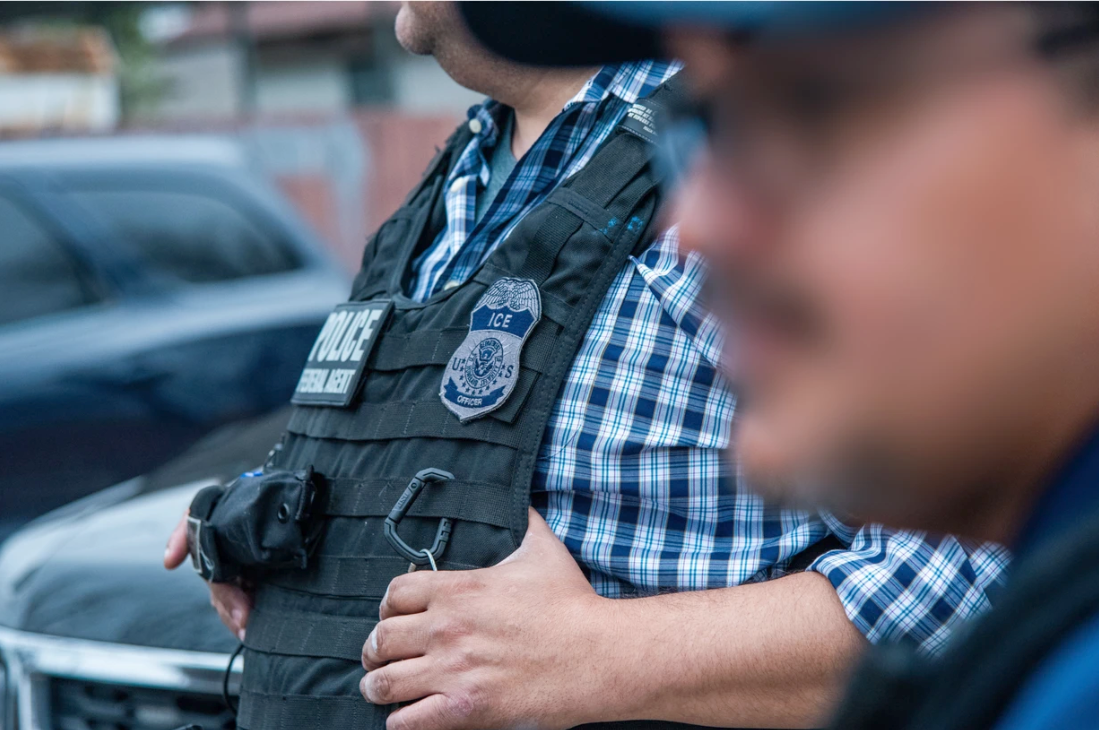This story originally appeared in New York Focus, a nonprofit news publication investigating power in New York. Sign up for their newsletter here.
NEW YORK STATE · September 29, 2025
The Migrant Relocation Assistance Program helped families leave crowded shelters and put down roots. Trump’s immigration crackdown is upending that.
By Isabelle Taft , New York Focus

ICE has detained or deported members of at least 19 current or former MRAP families around Rochester, Buffalo, and Albany since Trump took office. / US Immigration and Customs Enforcement
K and her husband were eager to settle down after a harrowing migration. They left Colombia for the United States last year with their infant son, reaching the southern border in May 2024. From Texas, they traveled to New York City by bus, ending up in a hotel shelter for newly arrived immigrant families.
That’s when New York state stepped in. The Migrant Relocation Assistance Program, a $32 million initiative launched in 2023, helped the family relocate to Rochester in May. Program funds paid for their move and first year of rent. K was relieved to escape the hotel, where she wasn’t allowed to cook, and the family settled into a routine: Her husband delivered food for DoorDash and Uber Eats, while she took care of their son at home.
Then, one morning in July, federal Immigration and Customs Enforcement agents arrested her husband outside their apartment. The couple, who met as children, were separated for the first time in 14 years.
“I don’t know what to do,” K, who requested anonymity because she fears being targeted by immigration authorities, said in Spanish. Instead of planning her family’s future, she feels frozen as she waits to find out what will happen to her husband. She hasn’t been able to work to make up for the loss of his income, she said: “I don’t know anyone here and I have no one to take care of the baby.”
The state has spent tens of millions to resettle families like K’s through MRAP. Most participants have work permits and a path to permanent legal status through pending asylum cases. They’ve finally found some stability after getting shuffled from city to city, but it has begun to unravel as President Donald Trump’s administration moves to dismantle the asylum system and expel applicants.
ICE has detained or deported members of at least 19 current or former MRAP families around Rochester, Buffalo, and Albany since Trump took office, program administrators told New York Focus. That number may be even higher in those cities and around the state, the administrators said.
Some of those arrested have signed voluntary departure paperwork to return to their home countries rather than face additional months or years in detention. Others are still locked up. Two former MRAP families — five children among them — were deported to Colombia from Buffalo, according to administrators and a local immigrant rights advocate.
“There’s so much uncertainty.”
—Deisi Sandoval, MRAP case manager
The arrests highlight the vulnerability of many people who arrived during a wave of immigration under the Biden administration. Blue states like New York launched programs that aimed — however imperfectly — to help new arrivals find housing and jobs. Now, they appear powerless to protect the beneficiaries of those programs.
ICE arrests have left affected MRAP families in limbo, and stoked dread among others, making it harder for them to build stable lives, said Deisi Sandoval, a case manager for 20 MRAP families in Rochester and herself a former beneficiary of the program.
“There’s so much uncertainty and so much fear and so much anxiety,” Sandoval said of program recipients. “They don’t see a future.”
A wave of migration hit New York City starting in 2022. Hundreds of thousands of asylum seekers and other immigrants arrived, some on buses chartered by Texas Governor Greg Abbott. As they crowded into shelters in hotels and tent camps, the city turned to the state for help, and MRAP was part of its response.
City shelter workers recruited participants to move to Westchester, Long Island, Albany, Rochester, or Buffalo, where the state program would pay a year’s rent and connect them with case management services. Only families who’d applied for protection from deportation, such as asylum, were eligible.
The program’s rollout was slow, prompting criticism from housing advocates. It ultimately served about half the number of families it was supposed to before the state stopped enrolling new participants this summer. Still, for families like K’s, MRAP was a much-needed lifeline. Her family moved to Rochester knowing no one, but their paid-for apartment offered enough stability to plan for the future.
Almost as soon as Trump was elected last November, program administrators started fielding anxious inquiries from MRAP families. They wondered if they’d get swept up in his promised “mass deportations.” Some asked if they should leave for Canada, one administrator said.
For the first few months of the new administration, program administrators in Rochester said they did not hear about their current or former clients having problems with immigration authorities. That changed in July, when ICE detained four men from some of Rochester’s MRAP families, according to the Ibero-American Action League, which contracted with the state to oversee the program in that city. All four men had work permits and asylum cases, Ibero administrators said.
K was still asleep when her husband headed out to work on July 31. She awoke to a phone call: “Bring me the immigration papers,” he said. She headed downstairs with paperwork showing he had a court date in 2029 for his asylum case, as well as his work permit and driver’s license.
ICE agents were right outside with her husband. “They told me that it was all right, that it was all in order, but all the same they were going to take him in,” she said.
K said the agents wanted to go into the apartment building, where several other MRAP families lived. “They were asking for more men,” she said. She told them none of the other men were home. They left, taking her husband with them.
“They were asking for more men.”
—K
He has been detained at the ICE detention center in nearby Batavia ever since, she said. He’s struggled to decide what to do next. At a court appearance in early September, he told a judge he was looking for an attorney to fight his case, but he’s also talked about wanting to sign paperwork to leave the country, K said, though he fears returning to his native Venezuela.
“He says that he doesn’t want to spend one, two, three years wasting his time there, when he didn’t do anything wrong here,” she said.
The Trump administration has enacted policies to keep people facing deportation locked in detention for the months or years it takes for their cases to play out. According to Ibero, three of the arrested Rochester MRAP participants have signed voluntary departure orders so they can leave detention.
In Buffalo, members of at least nine MRAP families out of 70 who settled in the city have had a member detained, in addition to the two families that were deported to Colombia, according to Darcy Kennedy-Ellis, director of asylum programs at Jericho Road Community Health Center, the organization that administered the program there. Some remain in detention, Kennedy-Ellis said. Recently, former MRAP participants who used to call her for advice navigating the bus system or signing up for health insurance have called to beg for help after a spouse’s detention, she said.
Sandoval, the case manager in Rochester, said the enforcement crackdown has injected uncertainty into every moment of her clients’ lives, from taking their kids to school to weighing whether to attend an immigration court hearing.
“The anxiety is so great that it ends up really affecting their adaptation process, because it doesn’t let them envision their life over the long-term,” she said.
New York Focus found no indication that ICE has targeted families because of their participation in MRAP. Rather, they’ve been caught up in a dragnet that has transformed life for many immigrants in western and upstate New York: In the first seven months of 2025, ICE arrests in the Buffalo Field Office Area of Responsibility — which includes all but 14 of the state’s 62 counties — were nearly double the amount in all of 2024, according to data published by the Deportation Data Project and analyzed by New York Focus.
In the past, most immigrants in the US with active asylum cases have awaited their court dates while free. ICE has started detaining some of them instead. One Rochester MRAP participant was arrested after his immigration court hearing at a federal building in New York City, his wife told Ibero administrators.
Making matters worse, MRAP services did not include legal representation, and many participants have been unable to find lawyers.
K’s search for an attorney to represent her detained husband has so far been fruitless. The nonprofit providers are swamped. When an attorney does call her back, she can’t tell if they’re trying to scam her, and she can’t afford to waste a cent, she said.
Lately, she said, she’s been asking herself what she’ll do if her husband is deported. They traveled here together, and the thought of trying to return home alone with their baby scares her.
“I don’t know how to leave,” she said.
